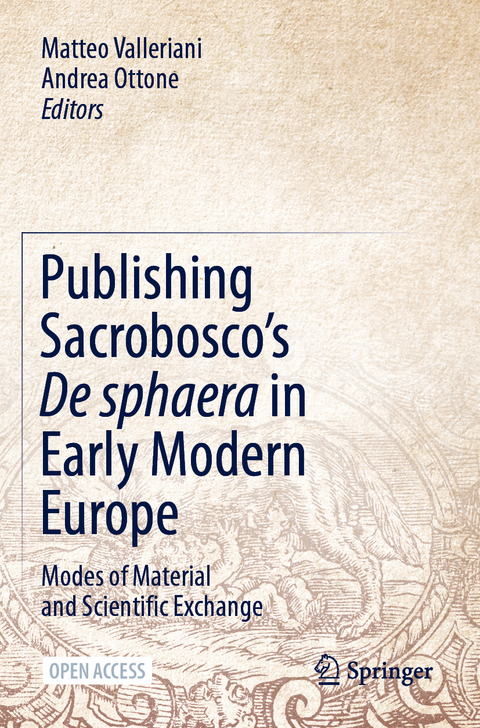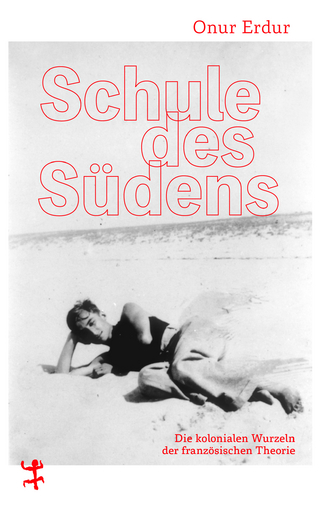
Publishing Sacrobosco’s De sphaera in Early Modern Europe
Springer International Publishing (Verlag)
978-3-030-86602-0 (ISBN)
This open access volume focuses on the cultural background of the pivotal transformations
of scientific knowledge in the early modern period.
It investigates the rich edition history of Johannes de Sacrobosco's Tractatus de sphaera,
by far the most widely disseminated textbook on geocentric cosmology, from the unique
standpoint of the many printers, publishers, and booksellers who steered this text from
manuscript to print culture, and in doing so transformed it into an established platform
of scientific learning. The corpus, constituted of 359 different editions featuring
Sacrobosco's treatise on cosmology and astronomy printed between 1472 and 1650,
represents the scientific European shared knowledge concerned with the cosmological
worldview of the early modern period until far after the publication of Copernicus' De
revolutionibus orbium coelestium in 1543.
The contributions to this volume show how the academic book trade influenced the
process of homogenization of scientific knowledge. They also describe the material
infrastructure through which such knowledge was disseminated, and thus define the
premises for the foundation of modern scientific communities.
lt;b>Matteo Valleriani is Research Group Leader in Dept. I, Honorary Professor at the Technische Universität Berlin, Professor for Special Appointments at the Faculty of Humanities at Tel Aviv University, and Principal Investigator of the Project "Images and Configurations in Corpora of University Textbooks" at the Berlin Center for Machine Learning. In his research, he investigates processes of 1) emergence of scientific knowledge in relation to its practical, social, and institutional dimensions, and 2) homogenization of scientific knowledge in the framework of Cultural Heritage Studies. Centering on cosmological knowledge, Matteo Valleriani's current major research project is concerned with the evolution of the scientific knowledge system and with the establishment of a shared scientific identity in Europe in the period between the thirteenth and the seventeenth centuries. In the frame of this project he also co-develops and implements multi-layered network models (sphaera.mpiwg-berlin.mpg.de). A further focus of his research is on the epistemic function of visual material in scientific research and in the framework of processes of knowledge transformation. Within this context he co-develops and applies machine learning technologies. Among his major publications: The Structures of Practical Knowledge, Springer Nature, 2017, Metallurgy, Ballistics and Epistemic Instruments: The "Nova Scientia" of Nicolò Tartaglia. A New Edition, Edition Open Access, 2013, Galileo Engineer, Springer, 2010. Andrea Ottone is currently a post-doctoral fellow at the Department of Economics of the University of Milan where he collaborates with Angela Nuovo's ERC founded project EMoBookTrade. In the frame of this project he studies the economic background of Venice's book industry in the Renaissance, with particular reference to costs and prices and the methods of market assessment. He is also fellow at Max-Planck-Institut für Wissenschaftsgeschichte, Berlin where he partakes to Matteo Valleriani's Sphaera project. In this context he assists the prime investigator in studying the mechanisms of material circulation Sacrobosco's printed editions in late Renaissance early Baroque Europe. He holds an adjunct position at the Technische Universität Berlin where he offers classes of European history with a focus on the history of communication, history of science in the frame of the Counter Reformation, and Renaissance empiricism in political thinking. Between 2007 and 2015, in the capacity of Graduate Teaching Associate, he taught classes of Western civilization and European history at the Ohio State University (Columbus, Ohio). Between 2002 and 2012, in the frame of the RICI program (an Italy based project involving the University of Rome "La Sapienza," University of Rome "Tre," University of Milan "Cattolica" and University of Macerata), he extensively explored topics related to Cinquecento book censorship, Counter Reformation institutions, book circulation and the morphology of private and common book collections.
Matteo Valleriani & Andrea Ottone The Early Modern Academic Book Market Seen Through The Sphere of Sacrobosco.- Section 1: Production Dynamics.- Richard Oosterhoff The Sphere and the Estienne Print Shop in Paris .- Catherine Kikuchi Erhard Ratdolt ' s Edition of the Sphaera A New Editorial Model in Venice?.- Insa-Christiane Hennen Printers, Publishers and Book Binders in Wittenberg in the Sixteenth Century: Real Estate, Vicinity, Political and Cultural Activities.- Saskia Limbach Publishing the «Sphaera» in Sixteenth-Century Wittenberg.- Section 2: Distribution Dynamics.- Ian Maclean Sacrobosco at the Book Fairs, 1564-1624: The Pedagogical Marketplace.- Alejandra Ulla Lorenzo Exploring the Circulation of Sacrobosco's Tractatus de sphaera in Early Modern Iberian Peninsula and New World Printing.- Andrea Ottone The Giunti's Publishing and Distributing Network and Their Supply to the European Academic Market.- Isabelle Pantin Mathematical Books in Paris (1531-1563): The Development of Editorial Policies in a Competitive International Market.- Matteo Valleriani & Christoph Sander Exploring Social Relations Between Early Modern Publishers and Printers by Means of Paratexts.- Section 3: Usage Dynamics.- Paul F. Grendler The «Sphaera» in Jesuit Astronomical and Mathematical Education.- Richard Kremer Printing Sacrobosco in Leipzig, 1488-1520: Local Markets and " Academic" Publishing.- Alissar Levy Publishing Mathematical Books to «Calculatores» in Paris (1508-1515).- Stefano Gulizia Traces of The Sphere in Early Modern Poland and in the German/Baltic Cultural Region.
"There is much in this collection that should interest historians of early modern science, as well as historians of early modern print culture and visual culture. This edited volume is part of a multiyear project at the Max Planck Institute for the History of Science ... . Written in the 13th-century in Paris, this slim text was taught in universities across Europe until the end of the 17th century." (Kathleen Crowther, Journal for the History of Astronomy, Vol. 54 (3), August, 2023)
| Erscheinungsdatum | 18.01.2022 |
|---|---|
| Zusatzinfo | XIV, 492 p. 72 illus., 70 illus. in color. |
| Verlagsort | Cham |
| Sprache | englisch |
| Maße | 155 x 235 mm |
| Gewicht | 771 g |
| Themenwelt | Geisteswissenschaften ► Philosophie ► Geschichte der Philosophie |
| Geisteswissenschaften ► Philosophie ► Philosophie der Neuzeit | |
| Naturwissenschaften | |
| Schlagworte | Academic Book Market • De sphaera mundi • Early Modern Prints • Erhard Ratdolt • Estienne Print Shop • history of astronomy • Ioannis de sacro Bosco • Johannes de Sacrobosco • open access • The Giunti's Publishing and Distributing Network • The Giunti’s Publishing and Distributing Network • The Pedagogical Marketplace • Tractatus de Sphaera |
| ISBN-10 | 3-030-86602-5 / 3030866025 |
| ISBN-13 | 978-3-030-86602-0 / 9783030866020 |
| Zustand | Neuware |
| Haben Sie eine Frage zum Produkt? |
aus dem Bereich


